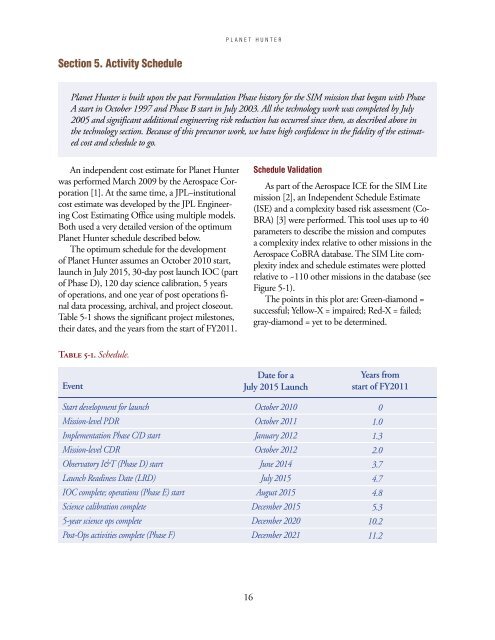Planet Hunter - Exoplanet Exploration Program - NASA
Planet Hunter - Exoplanet Exploration Program - NASA
Planet Hunter - Exoplanet Exploration Program - NASA
Create successful ePaper yourself
Turn your PDF publications into a flip-book with our unique Google optimized e-Paper software.
PLANET HUNTER<br />
Section 5. Activity Schedule<br />
<strong>Planet</strong> <strong>Hunter</strong> is built upon the past Formulation Phase history for the SIM mission that began with Phase<br />
A start in October 1997 and Phase B start in July 2003. All the technology work was completed by July<br />
2005 and significant additional engineering risk reduction has occurred since then, as described above in<br />
the technology section. Because of this precursor work, we have high confidence in the fidelity of the estimated<br />
cost and schedule to go.<br />
An independent cost estimate for <strong>Planet</strong> <strong>Hunter</strong><br />
was performed March 2009 by the Aerospace Corporation<br />
[1]. At the same time, a JPL–institutional<br />
cost estimate was developed by the JPL Engineering<br />
Cost Estimating Office using multiple models.<br />
Both used a very detailed version of the optimum<br />
<strong>Planet</strong> <strong>Hunter</strong> schedule described below.<br />
The optimum schedule for the development<br />
of <strong>Planet</strong> <strong>Hunter</strong> assumes an October 2010 start,<br />
launch in July 2015, 30-day post launch IOC (part<br />
of Phase D), 120 day science calibration, 5 years<br />
of operations, and one year of post operations final<br />
data processing, archival, and project closeout.<br />
Table 5-1 shows the significant project milestones,<br />
their dates, and the years from the start of FY2011.<br />
Schedule Validation<br />
As part of the Aerospace ICE for the SIM Lite<br />
mission [2], an Independent Schedule Estimate<br />
(ISE) and a complexity based risk assessment (Co-<br />
BRA) [3] were performed. This tool uses up to 40<br />
parameters to describe the mission and computes<br />
a complexity index relative to other missions in the<br />
Aerospace CoBRA database. The SIM Lite complexity<br />
index and schedule estimates were plotted<br />
relative to ~110 other missions in the database (see<br />
Figure 5-1).<br />
The points in this plot are: Green-diamond =<br />
successful; Yellow-X = impaired; Red-X = failed;<br />
gray-diamond = yet to be determined.<br />
Table 5-1. Schedule.<br />
Event<br />
Start development for launch<br />
Mission-level PDR<br />
Implementation Phase C/D start<br />
Mission-level CDR<br />
Observatory I&T (Phase D) start<br />
Launch Readiness Date (LRD)<br />
IOC complete; operations (Phase E) start<br />
Science calibration complete<br />
5-year science ops complete<br />
Post-Ops activities complete (Phase F)<br />
Date for a<br />
July 2015 Launch<br />
October 2010<br />
October 2011<br />
January 2012<br />
October 2012<br />
June 2014<br />
July 2015<br />
August 2015<br />
December 2015<br />
December 2020<br />
December 2021<br />
Years from<br />
start of FY2011<br />
0<br />
1.0<br />
1.3<br />
2.0<br />
3.7<br />
4.7<br />
4.8<br />
5.3<br />
10.2<br />
11.2<br />
16
















